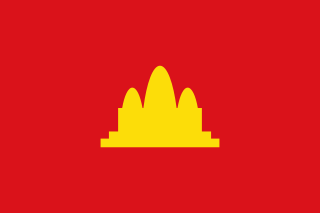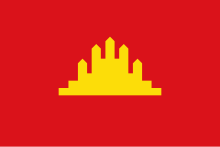
The Việt Minh was a national independence coalition formed at Pác Bó by Hồ Chí Minh on 19 May 1941. Also known as the Việt Minh Front, it was created by the Indochinese Communist Party as a national united front to achieve the independence of the Democratic Republic of Vietnam.

The Kingdom of Cambodia, also known as the First Kingdom of Cambodia, and commonly referred to as the Sangkum period, refers to Norodom Sihanouk's first administration of Cambodia from 1953 to 1970, an especially significant time in the country's history. Sihanouk continues to be one of the most controversial figures in Southeast Asia's turbulent and often tragic postwar history. From 1955 until 1970, Sihanouk's Sangkum was the sole legal party in Cambodia.

The Khmer Issarak was a "loosely structured" anti-French and anti-colonial independence movement. The movement has been labelled as “amorphous”. The Issarak was formed around 1945 and composed of several factions, each with its own leader. Most of the Issarak factions fought actively between the end of the Second World War in 1945 and Cambodia’s independence in 1953. The initial objectives of the Khmer Issarak was to fight against the French in order to gain independence, before later focusing on overthrowing the Cambodian government. The term Issarak originally referred to non-communist, but in the early 1950s the Việt Minh guided-guerrillas branded themselves Issaraks for the sake of unifying other non-communist forces.

Sơn Ngọc Thành was a Cambodian nationalist and republican politician, with a long history as a rebel and a government minister.
Sơn Ngọc Minh, also known as Achar Mean (អាចារ្យមាន), was a Cambodian achar and communist politician whose first notable career achievement was in 1950 when he was appointed the head of provisional revolutionary government of the United Issarak Front organised at Hồng Dân. Among his Vietnamese friends, he was known as Phạm Văn Hua.

The United Issarak Front was a Cambodian anti-colonial movement 1950–1954, organized by the left-wing members of the Khmer Issarak movement. The UIF coordinated the efforts of the movement as of 1950, and waged war against the French Union forces. At the time of the Geneva Peace Conference in 1954, it is estimated that UIF controlled about half of the Cambodian territory.

Yat Hwaidi was a Khmer politician, born in Surin province, Thailand. During the Second World War, he was the local education supervisor of the Thai administration in Siem Reap. He also represented the Phibunsongkhram Province in the parliament of Thailand. After the war, he joined the Khmer Issarak and pledged allegiance to Dap Chhuon and Kao Tak.
Tiv Ol was a Cambodian teacher and communist politician. Ol joined the Kampuchean People's Revolutionary Party in autumn 1959.

General elections were held in Cambodia on 9 June 1955. The elections were held following the peace established at the 1954 Geneva Conference and the independence of the country. The election were postponed to September 1955. The result was a landslide victory for the Sangkum party, which won all 91 seats. The election was marked by widespread voter fraud and intimidation. This began a period of one-party dominance of Prince Sihanouk's Sangkum until the coup of 1970.
Nguon Hong was a Cambodian Issarak guerrilla chief. Hong led a small group in Kompong Chhnang who has under Savang Vong's command. Around 1952, Nguon Hong and his group defected from Savang Vong, and joined Son Ngoc Thanh's forces. However, Nguon Hong also aligned with the United Issarak Front chief in the area, Meas Vong. In this sense Nguon Hong represented an emerging phenomenon of the unity between nationalist (Thanh) and communist forces in the Cambodian anticolonial struggle at the time.
Nop Bophann was a Cambodian newspaper editor. He had been one of the representatives of the United Issarak Front in the Viet Minh side of the Joint Commission for the Implementation of the Geneva Accords. In May 1956, Nop Bophann, along with Non Suon and Keo Meas, restarted Pracheachon as a weekly newspaper. Nop Bophann became the editor of the publication. On October 11, 1959, Nop Bophann was shot dead outside a military barrack in Phnom Penh.
Keo Meas was a Cambodian communist politician. Keo Meas, then a fourth-year student at the Phnom Penh Teachers Training College, was recruited to the Indochinese Communist Party by Son Sichan in 1946. In 1950, he became a leading figure within the United Issarak Front. At the same time he was a leading figure in the Phnom Penh city unit of the ICP.

PrinceNorodom Chantaraingsey was a member of the Cambodian royal family and a Cambodian nationalist. Initially a leader of the guerrilla resistance against the colonial French, he went on to become a prominent general in the Khmer National Armed Forces (FANK) during the Cambodian Civil War, as well as a businessman and occasional writer.
Tou Samouth, also known as Achar Sok (អាចារ្យសុក), was a Cambodian politician. One of the two founding members of the Kampuchean People's Revolutionary Party (KPRP), the other being Son Ngoc Minh, and head of its more moderate faction. He is mainly remembered for mentoring Saloth Sar, who would later change his name to Pol Pot.
Dap Chhuon, also known as Chuan Khemphet, Khem Phet, Chhuon Mochulpech or Chhuon Mchoul Pich (1912–1959) was a right-wing Cambodian nationalist, guerrilla leader, regional warlord, and general.
The Krom Pracheachon, often referred to simply as Pracheachon, was a Cambodian political party that contested in parliamentary elections in 1955, 1958 and 1972.
The Samlaut Uprising, otherwise called the Samlaut Rebellion or Battambang Revolts, consists of two significant phases of revolts that first broke out near Samlaut in Battambang Province and subsequently spread into surrounding Provinces in Cambodia during 1967-1968. The revolutionary movement was largely made up by the dissident rural peasantry led by a group of discontented leftist intellectuals against Prince Norodom Sihanouk’s political organization –the Sangkum regime.
Hem Chieu was a Cambodian Buddhist monk and a prominent figure in the development of Khmer nationalism.
Saloth Chhay was a Cambodian left-wing journalist and political activist, who was prominent in the country's politics during the 1950s, 1960s and 1970s. He is best known for being the older brother of Pol Pot, future leader of the Khmer Rouge communists, and for influencing his early political development.

The Communist Party of Kampuchea (CPK), also known as the Khmer Communist Party, was a communist party in Cambodia. Its leader was Pol Pot and its followers were generally known as the Khmer Rouge. Originally founded in 1951, the party was split into pro-Chinese and pro-Soviet factions as a result of the Sino–Soviet split with the former being the Pol Pot faction, and the latter adopting a more revisionist approach to Marxism. As such, it claimed 30 September 1960 as its founding date, then as the Workers' Party of Kampuchea before being renamed the Communist Party in 1966.









